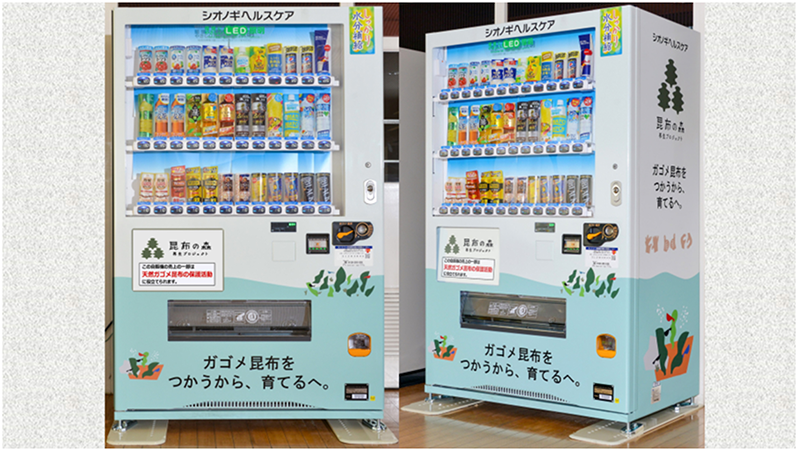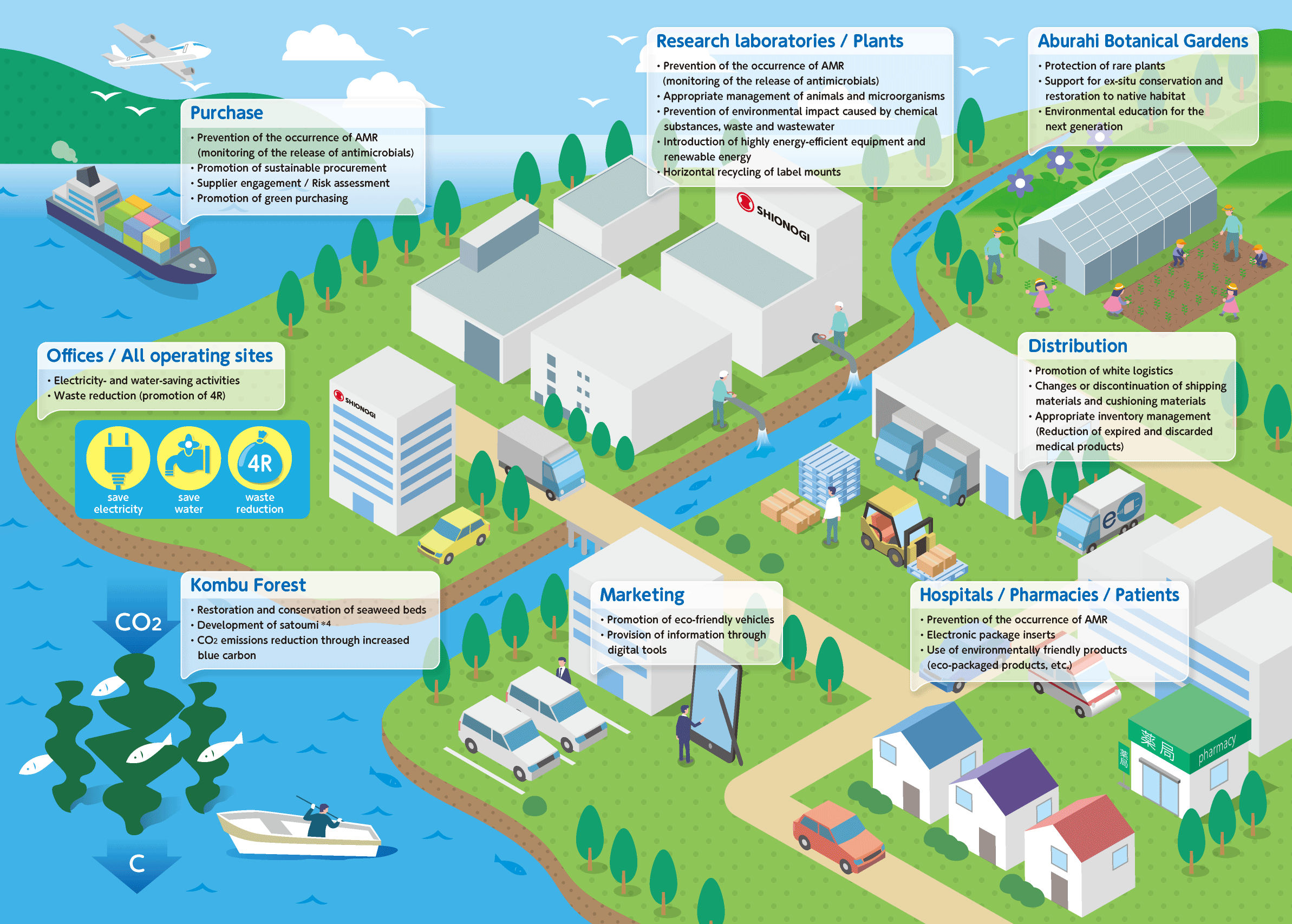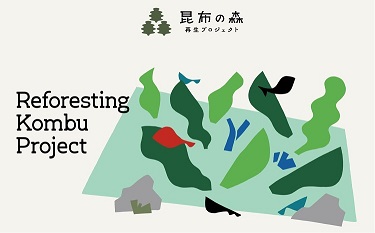Biodiversity
Biodiversity Initiatives
Governance
SHIONOGI recognizes that initiatives for biodiversity issues are as important as those for climate change issues and promotes measures to address these issues under a common governance structure. We have established an integrated EHS management function that unifies and manages various activities related to the environment, health, and, safety (“EHS”). The progress of specific measures against biodiversity risks is managed by this EHS function.
See the section “SHIONOGI’s Climate Change Strategies” for information on the relationship with the integrated EHS management function and the Enterprise Risk Management system.
Participation in Initiatives
SHIONOGI has endorsed the Declaration of Biodiversity by Keidanren and Action Policy (Revised Edition) and has announced its environmental policy for the future and specific examples of environmental initiatives through the Keidanren Initiative for Biodiversity Conservation.
Keidanren Initiative for Biodiversity Conservation (External website)
Moreover, in September 2023, we joined the 30by30 Alliance for Biodiversity, a platform that consists of volunteer companies, local governments, and organizations, supporting its founding purpose of “promoting efforts to achieve the 30by30 target, an international target of protecting or conserving at least 30% of land and sea areas by 2030.” We will continue to strengthen our activities to conserve biodiversity, aiming for the international goal of Nature Positive to halt and reverse biodiversity loss by 2030.
Ministry of the Environment: 30by30 Alliance for Biodiversity (External website)
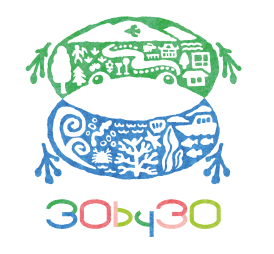
Relationship between Business Activities and Nature
As a social movement regarding biodiversity, the Kunming-Montreal Biodiversity Framework*2 was adopted at the 15th Conference of the Parties to the Convention on Biological Diversity (COP15) in December 2022, and the Task Force on Nature-Related Financial Disclosures (TNFD)*3 framework was published in September 2023. In both frameworks, companies are required to identify and assess their dependence and impact on biodiversity and biodiversity risks and opportunities in business, and take the necessary measures for sustainable consumption (based on the LEAP approach).
SHIONOGI analyzes and organizes the connection between its business activities and nature, as well as the impact that its business activities have on the natural environment through this connection and its biodiversity initiatives to reduce this impact, focusing on direct operations in its pharmaceutical business and the upstream of the supply chain. Based on the results, we will continue to strengthen our effective efforts to conserve biodiversity.
*2 Kunming-Montreal Biodiversity Framework: A global goal for biodiversity to be achieved by 2030, following the Aichi Biodiversity Targets, a set of global targets by 2020 adopted at COP 10
*3 TNFD: A framework for companies and financial institutions to assess their dependence on natural capital and impact on ecosystems, and provide information to investors and other stakeholders based on their assessment results
All industries depend on nature, and the pharmaceutical industry is no exception. The diagram on the right shows the relationship between the value chain that constitutes SHIONOGI’s business activities and nature. For example, in research laboratories and plants that are responsible for the research, development, and manufacturing of pharmaceuticals, there are occurrences of handling and disposal of chemical substances as well as the generation of waste and wastewater. If these chemical substances, waste, or wastewater accidentally leak into the environment around our operating sites, this could have a negative impact on nature and biodiversity. In addition, since SHIONOGI’s main medicinal products are antimicrobials, there is a risk of AMR occurring in the surrounding environment across all activities in the antimicrobial value chain. As seen above, SHIONOGI’s business activities are related to nature in many ways.
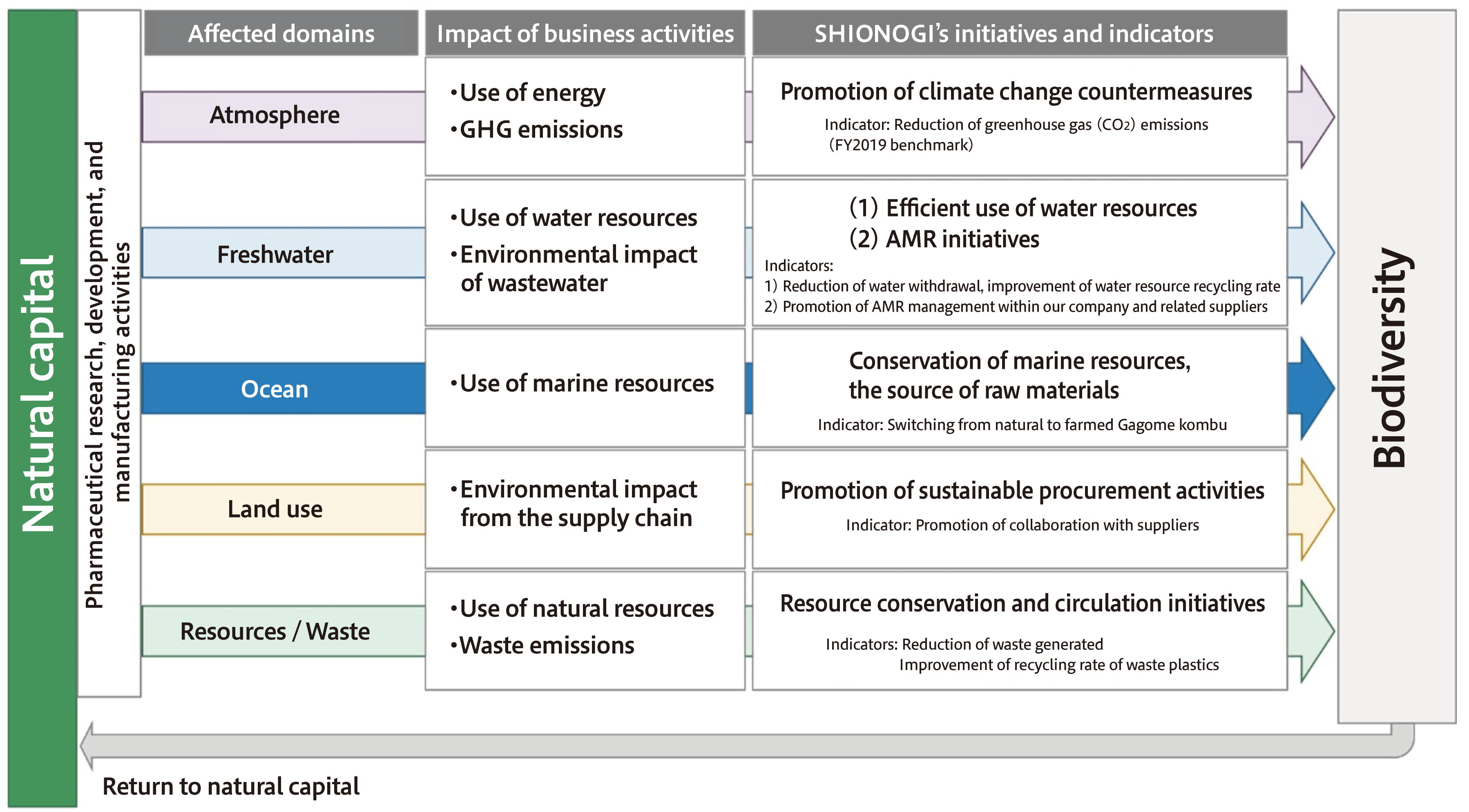
SHIONOGI’s Initiatives
SHIONOGI recognizes the impact of its business activities on the global environment, such as the consumption of natural resources, emissions into the atmosphere and water, and generation of waste. Believing that reducing environmental impact is an important issue, we are taking the following measures.
Table 1: SHIONOGI Group’s biodiversity initiatives
Main item |
Overview |
Related URL |
|---|---|---|
Reduction of impact on the surrounding environment based on laws and regulations |
・Promotion of compliance (Air Pollution Control Act, Water Pollution Control Act, Sewerage Act, Soil Contamination Countermeasures Act, etc.) |
・See this page for details |
・Appropriate management of chemical substances |
・See this page for details |
|
・Appropriate management of genetically modified organisms |
・See this page for details |
|
Climate change countermeasures aiming for carbon neutrality by 2050 |
・Promotion of efforts to reduce greenhouse gas emissions ・Introduction of electricity derived from renewable energy |
・See this page for details |
・Assessment of business risks and opportunities for SHIONOGI and information disclosure in relation to climate change |
・See this page for details |
|
Efficient use of water resources |
・Reduction of water resource usage |
・See this page for details |
AMR initiatives |
・Wastewater management at antimicrobial-manufacturing plants |
・See this page for details |
・Awareness-raising activities and information provision for the proper use of antimicrobials |
・See this page for details |
|
Resource conservation and circulation initiatives |
・Promotion of waste reduction, reuse, and recycling |
・See this page for details |
Promotion of sustainable procurement |
・Promotion of sustainable procurement activities based on the Procurement Policy |
・See this page for details |
Marine resource conservation activities |
・Promotion of the Reforesting Kombu Project |
・See this page for details |
Nature conservation activities and social contribution around our operating sites |
・Initiatives for conserving rare bird species ・Initiatives at the Aburahi Botanical Gardens ・Activities at our operating sites |
・See this page for details. |
Appropriate Management of Genetically Modified Organisms
Marine Resource Conservation Activities: Reforesting Kombu Project
Shionogi Healthcare Co, Ltd., our Group company that handles OTC drugs, manufactures and markets health foods that use fucoidan, a component extracted from Gagome kombu (kelp). However, due to a combination of reasons, such as an imbalance of supply and demand in the sea caused by the recent increase in sea urchins and abalones, which feed on seaweed, and overfishing caused by the Gagome kombu boom, natural Gagome kombu, which mainly inhabits the waters near Hakodate, Hokkaido Prefecture, is facing the crisis of possible extinction in the area.
As a company that handles products using Gagome kombu, Shionogi Healthcare has started the Reforesting Kombu Project to restore natural Gagome kombu to its former state in which it grew thickly like a forest. The purpose of the project is to switch our use from natural to farmed kombu, and to reduce the use of natural Gagome kombu to zero by the end of FY2024. Under the “Project for Promoting the Launch of Business Based on Local Community-Company Partnership” subsidized by the Ministry of Economy, Trade and Industry, we are collaborating with Hakodate City and local universities and companies to improve the quality of farmed Gagome kombu and promote the spread of farmed kombu by establishing a stable supply system. Thus, we are working to conserve and restore natural Gagome kombu. Starting in FY2019, we have begun using farmed Gagome kombu as a raw material for our products, and the rate of switching to farmed Gagome kombu reached over 50% in FY2023. In FY2024, we completed the switch to farmed Gagome kombu for our flagship product, the Fucoidan PROTECT series.
Going forward, we not only expect benefits for biodiversity conservation, but also consider initiatives aimed at contributing to blue carbon*5 through farmed kelp. By increasing farmed kelp, which serves as a carbon sink, we will contribute to the realization of a carbon-neutral society and advance multifaceted efforts to preserve the global environment.
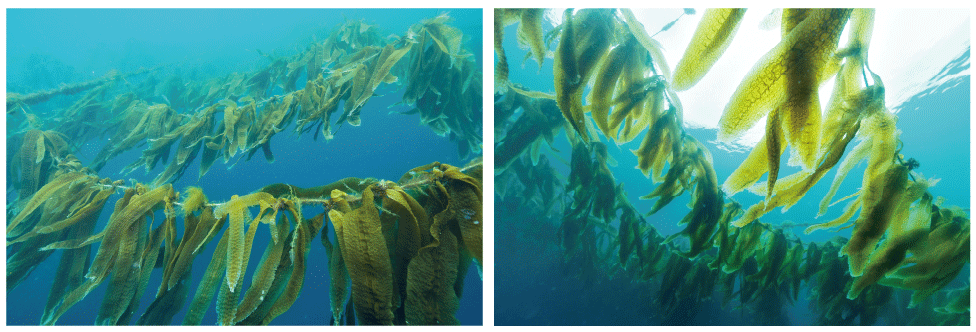
*5 Blue carbon
Blue carbon refers to the carbon that is taken from the atmosphere into the ocean by marine ecosystems such as seaweed beds and shallow reefs. Blue carbon sinks include seagrass beds, seaweed beds, tidal flats, and mangrove forests, which are called “blue carbon ecosystems.” Carbon dioxide absorbed through photosynthesis in blue carbon ecosystems passes through the bodies of living organisms as organic carbon and is stored on the ocean floor for a long period of time.
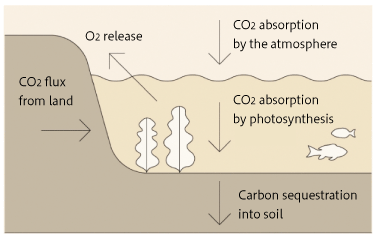
Nature conservation activities and social contribution around our operating sites
Initiatives for conserving rare bird species
In recent years, highly pathogenic avian influenza (HPAI) has been rampant, and there have been reports of mass deaths not only of poultry raised for human use such as chickens and ducks, but also of wild birds and mammals. HPAI also poses a major threat to rare bird species that are at risk of extinction.
In 2023, SHIONOGI launched a project to protect rare bird species from HPAI through the proper use of influenza drugs. In collaboration with the Hokkaido University One Health Research Center, the Institute for Raptor Biomedicine Japan, and the NPO Animal Hospital Okinawa, we work every day to achieve the goal of “establishing a system for the proper use of therapeutic drugs against infectious diseases that threaten biodiversity.” Based on the concept of “One Health,” which considers the health of the entire planet, including the health of not only humans but also animals and ecosystems and the environmental issues that affect them, we hope to contribute to halting the decline of biodiversity.
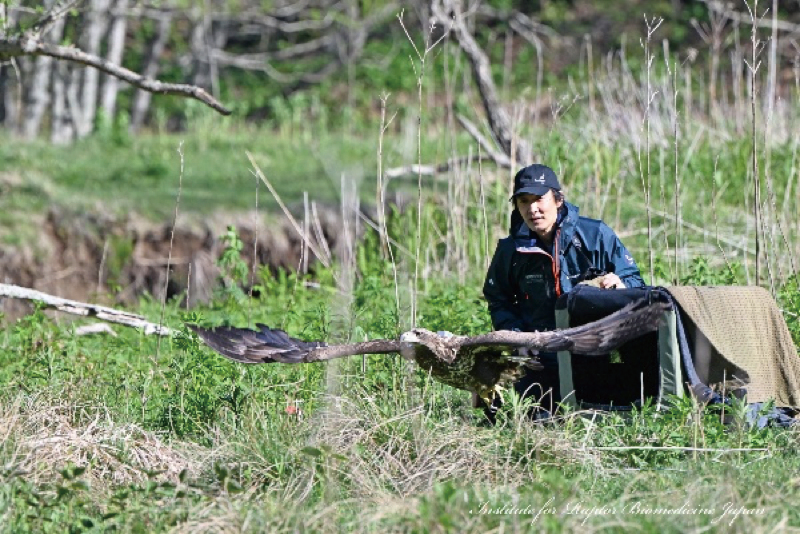
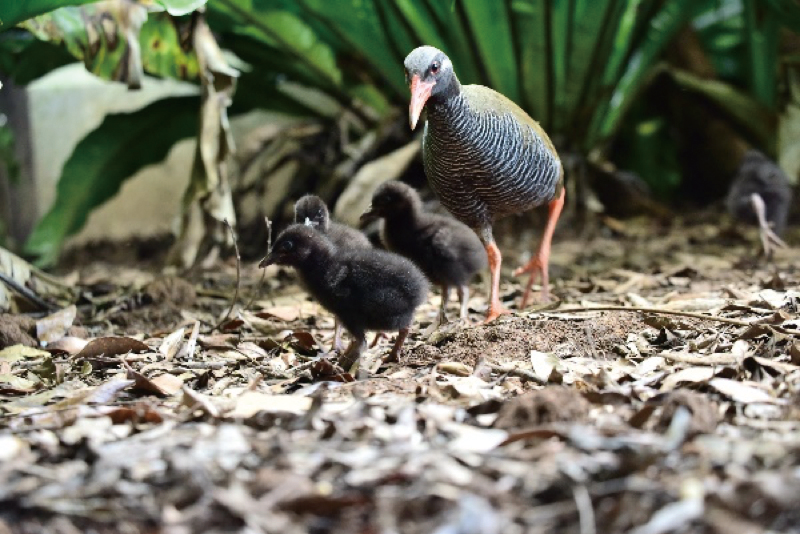
Initiatives at the Aburahi Botanical Gardens
Contribution to the conservation of threatened species
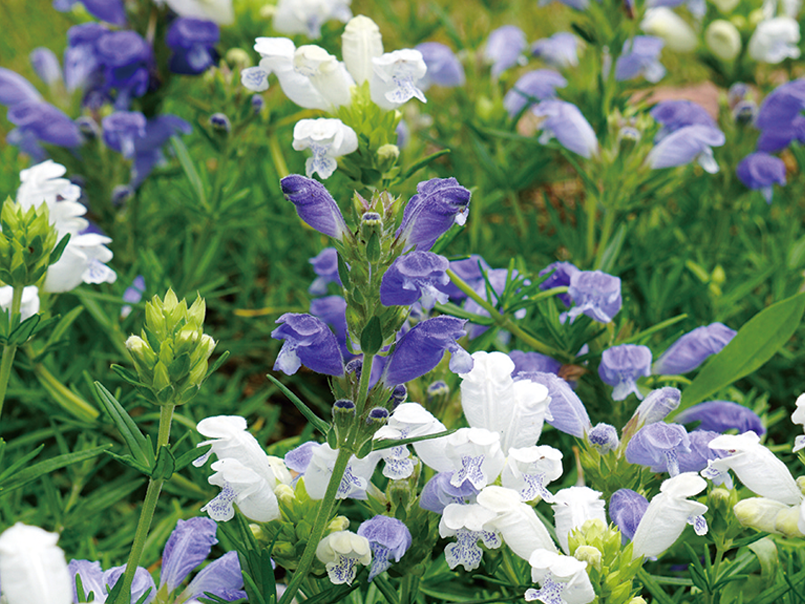
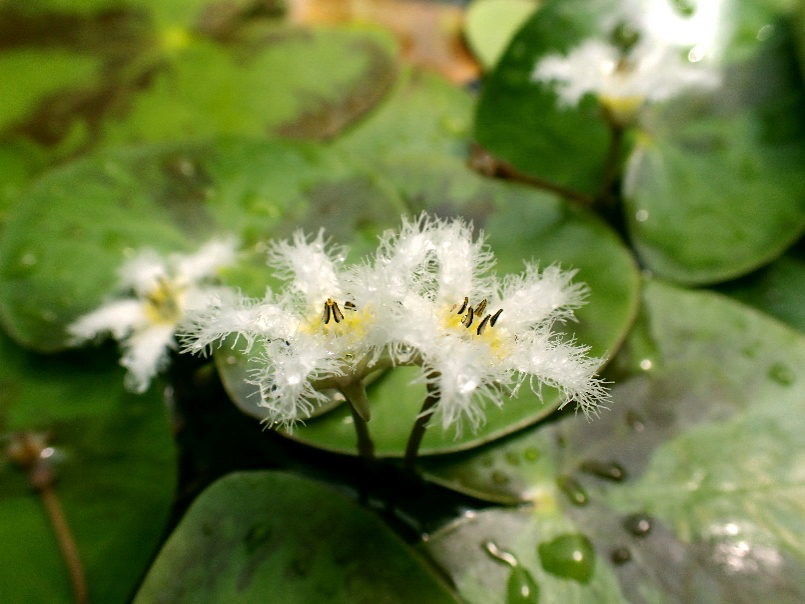
Conservation status of threatened species by category
Categories specified by the Ministry of the Environment (Endangered Class IA, Endangered Class IB, Endangered Class II, Near Threatened Class) |
73 species |
Categories specified by Shiga Prefecture (Endangered species, vulnerable species, rare species, species requiring attention, important species in terms of distribution, other important species) |
71 species |
Categories specified by Koka City (Extinct species, endangered species, vulnerable species, species requiring attention, local species) |
46 species |
Environmental education for stakeholders
As part of our social contribution activities for the local community through the Aburahi Botanical Gardens, we invite experts from Kyoto Pharmaceutical University to provide educational support to local elementary school students, who will lead the next generation. We also provide opportunities to learn about the environment by holding garden tours, targeting high school and university students, those enrolled in a university for seniors, and new employees of SHIONOGI.
Results
|
|
FY2021 |
FY2022 |
FY2023 |
|---|---|---|---|---|
Aburahi Botanical Gardens tour |
Number of times |
4 |
13 |
20 |
Total number of participants |
84 |
153 |
335 |
|
Total number of participating employees |
13 |
64 |
64 |
|
Visiting class |
Number of times |
4 |
4 |
4 |
Total number of participating employees |
12 |
20 |
18 |
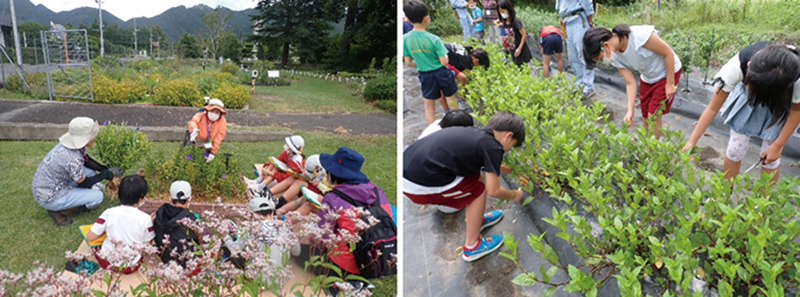
– Aburahi Botanical Gardens receives three stars in the Shiga Prefecture Certificate of Biodiversity Initiatives
The Aburahi Botanical Gardens received three stars, the highest rank, in the 2021 Shiga Prefecture Certificate of Biodiversity Initiatives because its community and social contribution activities, stated above, were evaluated as effective initiatives for the conservation of biodiversity and the sustainable use of natural resources.
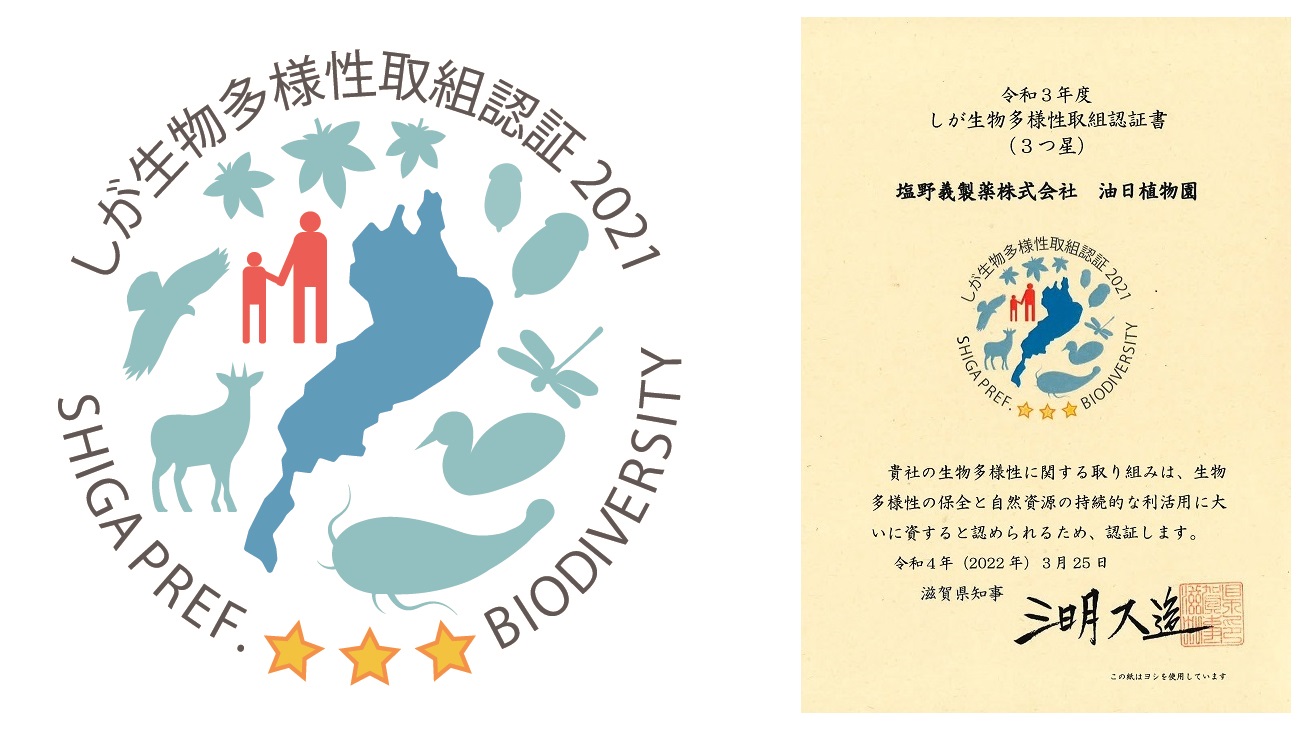
Community clean-up activities
Clean-up activities are conducted around our operating sites: Shionogi Pharmaceutical Research Center, Shionogi CMC Research Innovation Center, Shionogi Smile Heart, Shionogi Pharma’s Kanegasaki Plant, Settsu Plant, Tokushima Plant, Itami Plant, and Amagasaki Office, and UMN Pharma’s Akita Plant. At Shionogi Pharma’s Kanegasaki Plant, employees volunteer to help with snow removal during the winter. This activity also serves the role of watching over elderly people living alone to make sure they are staying healthy.
We also participate in various programs such as the Adopt Road Program run by Osaka Prefecture and the SpoGomi program run by the Social Sports Initiative, contributing to environmental conservation in the local community.
|
FY2021 |
FY2022 |
FY2023 |
|---|---|---|---|
Number of times |
21 |
75 |
94 |
Total number of participating employees |
381 |
721 |
882 |
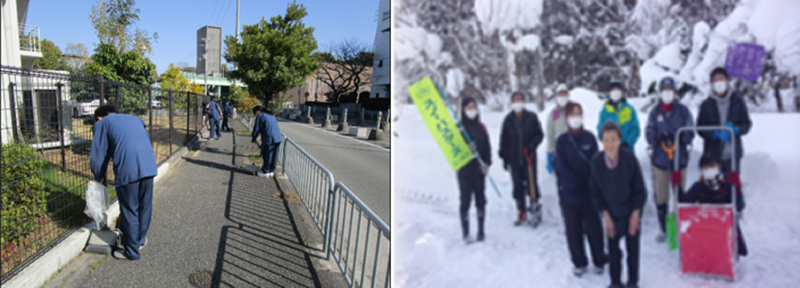
Other activities
Shionogi Smile Heart Co., Ltd., our Group company, is working on the Green Smile Initiative to green our operating sites across the country. This initiative recruits collaborators and supporters from among SHIONOGI’s employees nationwide to have them grow office plants while communicating with each other. This not only has a greening effect on our operating sites but also helps to raise employees’ environmental awareness. Shionogi Smile Heart is a special subsidiary company that employs people with disabilities, and through this initiative, it has helped to raise awareness of the employment of people with disabilities among Group employees and to promote DE&I.
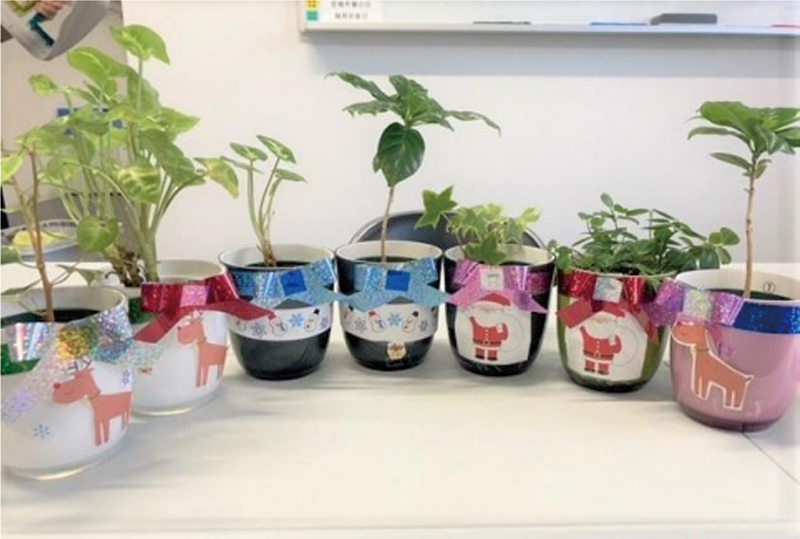
Moreover, as part of the efforts to contribute to environmental protection activities and biodiversity conservation, Shionogi Pharma and Shionogi Techno Advance Research Co., Ltd., which are our Group companies, collaborate with Suntory Beverage Solution Ltd. to install original vending machines in all their locations. By visualizing the SHIONOGI Group’s Aburahi Botanical Gardens’ initiative “Conservation and Management of Endangered Species and Medicinal Plants” and Shionogi Healthcare’s “Reforesting Kombu Project” on the vending machines, they provide the opportunity for employees to think about environmental conservation at random moments in their daily life, aiming to raise their environmental awareness. They also donate a portion of the vending machines sales to outside environmental protection organizations to contribute to resolving social issues.
